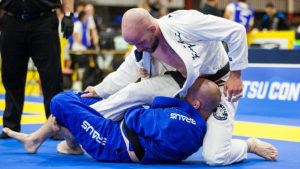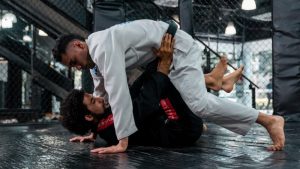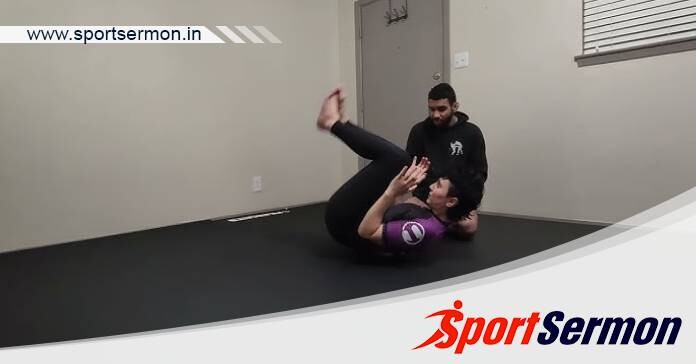The dynamic martial art of Brazilian Jiu-Jitsu thrives on the combination of skill and leverage. The numerous escapes and defensive techniques that enable a practitioner to avoid or resist an opponent’s control demonstrate this idea. The kipping escape is one of the several escapes taught in BJJ programmes throughout the world, and it’s a good alternative even when facing larger and more powerful opponents. The fundamentals of the Brazilian Jiu-Jitsu kipping escape will be covered in this article.
The Kipping Escape: What Is It?
Kipping escapes are defensive manoeuvres used to knock opponents off top pins. The kipping escape, which is typically utilised to get out of dangerous positions like side control and mount, is starting to gain popularity in today’s competitive scene. Getting inside position, framing against the opponent’s hips, and using momentum from the legs and hips to buck off the opponent on top are the main components of the kipping escape technique. As this essay progresses, we’ll dig further into the detailed motions.
You might also interested in reading this: How To Become Expert At BJJ Double Ankle Sweep?
When To Utilise The Kipping’s Escape?
The kipping escape is very useful when you’re fully mounted, stuck beneath an opponent in side control, or the opponent is trying to pass the guard. Your range of motion is limited in these circumstances, and the opponent’s pressure and weight might be too much to handle. The opponent’s balance may be upset by the kipping action, giving you the opportunity to regain the guard or move into a more advantageous position.
Kipping’s Escape From The Mount

Reputable BJJ black belt Brian Glick describes his method for the kipping escape. The kipping escape works best from beneath pins like the mount, as we have already explained. Gaining the inside position is essential to a strong kipping escape, as it serves as a frame against the opponent’s torso and hinders their ability to attack your arms with submissions. This is true of most BJJ defensive tactics.
Making space between your hips and your opponent’s is the aim of the kipping action, which gives you the chance to return to guard. It is not enough to only bridge to create space; you also need to shift at a little angle to regain your position and execute a jackknife action with your legs to produce force. Make sure you follow through on each step and don’t stop in the middle. Move to guards like the single leg X once you have adequate room to do so in order to manage and control the opponent’s weight.
Kipping’s Escape From Side Control
Many grapplers prefer side control since it gives them a significant advantage over their opponents. Learning to defend and get out of the side control position is crucial to your progress if you are new to Jiu-Jitsu.
The key to the kipping escape from side control, like it was in the mount variation we demonstrated, is to use a kipping action to push the hips to an angle instead of staying square. You will be able to enter your legs and regain guard at this angle.
Use your frames to defend yourself when you get your knee close to your opponent’s hip from the bottom side control posture. In order to produce force and motion fast, your legs should be bent and in contact with one another. To make room for your knees to enter the pocket close to their hips, push with your arms at an angle and do the kipping action, jacking your legs up and down. From this position, you may securely reclaim the guard and push away.
Advantages Of Using The Kipping Escape
Given its many excellent advantages, it is advised to at least investigate the kipping escape method. The kipping action is an effective way to make room. It trains your body to exert force by pushing someone over with an angle and displacement. The kipping escape is a technique that even little practitioners may benefit from since it builds power with the legs.
The novelty of the kipping escape is another advantage. It’s reasonable to state that hardly everyone knows about this way out. Take advantage of this feature and keep using the technique until both your opponents and training partners are forced to learn how to counter it.
Lastly, because of its adaptability, the kipping escape may be employed with or without the Gi. When creating our games, it’s critical that we select BJJ techniques that can be used to any style or set of regulations. While it’s not our top pick for side control and mount escapes, mastering the kipping escape is still a great skill to have in your toolbox. Remember that in Jiu-Jitsu, you have to have a technique for each key position. It won’t work to rely just on one tactic because you’ll soon discover it. Try a few different strategies one after the other to make your writing engaging and difficult to read.
Getting Ready for the Kipping Escape

It should be mentioned that mastering requires drilling and practising new postures. Though it appears straightforward, the kipping escape is actually quite complex. The key to this method is doing the kipping action correctly. If you are unable to provide sufficient force with your legs, it will be challenging to find a way to regain guard. It is advisable to train the kipping escape as much as possible in this situation.
In Summary
The kipping escape is proof of the focus on technique and leverage in the discipline. With an awareness of body mechanics and the ability to use momentum, even a smaller practitioner may break free from the hold of a stronger, larger opponent.

